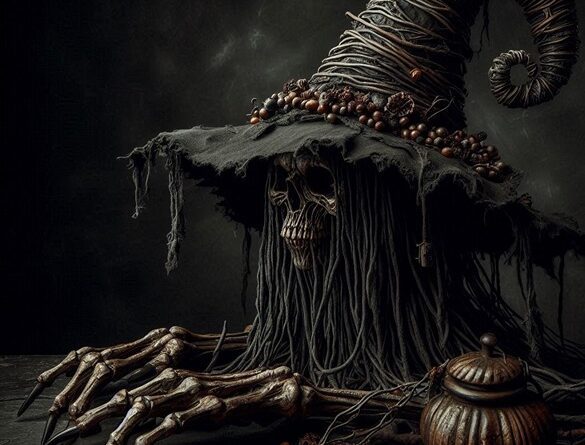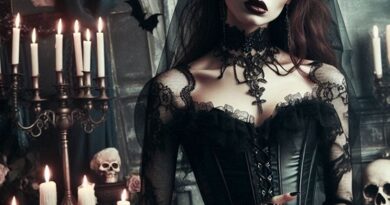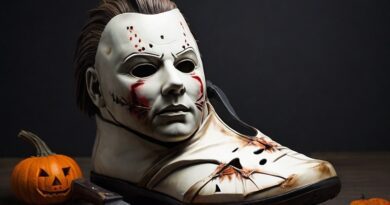The Witch Hat: Its Origins, Symbolism, and Where It Still Haunts Us Today
They say that the hat makes the man. Well, the truth is that the more common term refers to the clothes make the man, not the hat, but it turns out that there is a small work of art called “The Hat Makes the Man,” a mixed media and collage work on paper and cardboard, created by the German artist Max Ernst in 1920, so go for it.
In any case, hats are an integral part of scary fashion. Take familiar evil characters from the past or present. You will see that some of them wear a hat, such as a fedora, or something similar. For example, Freddy Krueger, the Leprechaun, the Invisible Man, The Babadook, the Jeepers Creepers, Art the Clown from the “Terrifier” movies, or “The Grabber” from “The Black Phone”. In the fashion catalog, hats get a place of honor. They evoke specific associations in us, including those related to the person wearing it. If you’ve seen “Wicked,” for example – and the writer of these lines has seen this film twice (!), even though it’s a horror film, because his wife requested it – you probably remember one of the best scenes in the movie, in which Elphaba wears an ugly witch’s hat to the ball that Galinda gives her as a “gift” to make fun of her. In the end, Galinda realizes her mistake, and the two become friends. However, it may be too late for Elphaba, and the hat is one of the reasons she went to the dark side.
If we return to our world, we can argue that a witch’s hat is one of the most common and recognizable items in the world of costumes. We’ve also seen an impressive presence of witches’ hats in folk tales and classic films, including horror films. But what are the roots of these hats? When did their connection to witches begin? Is there a reason to wear them outside of Purim, Halloween, or whatever you’re celebrating? And of course, where can you buy one?

What Does A Witch Hat Look Like?
The classic witch’s hat, as described in popular culture, has a straightforward design. The hat usually comes in black and consists of two main parts:
![]() A conical crown, which usually rises to a height of several tens of centimeters and ends in a narrow point. The crown creates an elongated and pointed shape, with a dramatic or even frightening element.
A conical crown, which usually rises to a height of several tens of centimeters and ends in a narrow point. The crown creates an elongated and pointed shape, with a dramatic or even frightening element.
![]() Wide and rounded brim, with a radius that in most cases is about 15-20 cm from the head. The brim is sometimes curved upwards to some extent at its edges, to create a dramatic character.
Wide and rounded brim, with a radius that in most cases is about 15-20 cm from the head. The brim is sometimes curved upwards to some extent at its edges, to create a dramatic character.
![]() Color – The traditional color of witch hats is deep black, likely to symbolize the darkness and mysticism associated with the figure of the witch. Here, we need to add a small asterisk, which is that over the years, the supply of fashionable hats has increased significantly, perhaps thanks to friendly and even sexy representations of witches (which, of course, contrasts with the image of the old and ugly witch from fairy tales). Today, you can find hats in a wide variety of shades, such as purple or dark green, as well as in colorful and happy patterns. If you want, hats that would be more suitable for Galinda, the “Good Witch”, and less for the Wicked Witch of the West.
Color – The traditional color of witch hats is deep black, likely to symbolize the darkness and mysticism associated with the figure of the witch. Here, we need to add a small asterisk, which is that over the years, the supply of fashionable hats has increased significantly, perhaps thanks to friendly and even sexy representations of witches (which, of course, contrasts with the image of the old and ugly witch from fairy tales). Today, you can find hats in a wide variety of shades, such as purple or dark green, as well as in colorful and happy patterns. If you want, hats that would be more suitable for Galinda, the “Good Witch”, and less for the Wicked Witch of the West.
![]() Raw material – Creators typically use felt as the standard material for making a witch’s hat, allowing the crown to maintain its pointed shape and the brim to be stable. In cheaper versions, the hat is made of synthetic fabrics or sturdy paper, whereas in higher-quality versions, manufacturers use real felt or velvet.
Raw material – Creators typically use felt as the standard material for making a witch’s hat, allowing the crown to maintain its pointed shape and the brim to be stable. In cheaper versions, the hat is made of synthetic fabrics or sturdy paper, whereas in higher-quality versions, manufacturers use real felt or velvet.

Where Did The Witch Hat Come From?
The historical roots of the witch’s hat are complex, or at least, far from unambiguous. We assume that the classic image of the witch with the pointed hat developed over centuries and was influenced by various factors on the religious, social, and, of course, cultural levels. One reason for the confusion is that history is replete with pointed hats, each with its varied context.
It is possible that traditional witch dressing began in China. In the Chinese region of Subshi, dating from the 4th to 2nd centuries BC, three mummies were found, nicknamed the “Witches of Subshi”. The findings showed that someone covered their hair with large, funnel-shaped accessories made of black felt.
The story begins, according to another popular view, in Europe during the Middle Ages. In those years, pointed hats were a standard item of clothing, not necessarily identified with witches. Upper-class women wore pointed hats as both a fashion item and a status symbol. Upper-class women used to wear, especially from the 15th century, relatively pointed hats called “hennin”. In the 19th century, another example was the top hat, which was common and resembled a cone with a fabric made of silk or cloth hanging from its tip.
According to one popular theory, the connection between witches and pointed hats began precisely with anti-Semitism. In 1215, the Fourth Council of the Lateran – an ecumenical conference in which the best bishops from the Christian world gathered – decided to order Jews to wear a head covering that would identify them. It was a pointed hat called a “Judenhut,” which translates to “Jewish Hat.” Jewish men were required to wear this yellow, pointed conical hat whenever they left the ghetto in medieval Europe, to distinguish them from the general population and to humiliate themselves. The hat is associated with terrible acts such as satanic worship or black magic, which Jews were accused of by the anti-Semites, hence the connection to witches.

Another theory presents a connection between witch hats and hatred of others, except that this time the victims are the Quakers (or “Religious Society of Friends”), a Christian community founded in Britain in the 17th century and known for pursuing peace and opposing violence, but opposing baptism into Christianity. Some believed that this minority group met with demons and practiced witchcraft. The Puritan reaction against the Quakers intensified in the 18th century, a period during which the figure of the witch with a pointed hat became a staple of American folklore. Although there is something that seems like a significant plot hole in this theory – the fact that Quakers did not wear pointed hats – some still see a particular, more indirect connection.
It is possible that witches’ hats grew out of… beers. Women who brewed home-brewed beer for sale wore hats that identified them, “women’s hats.” Many elements within the male beer industry opposed these women, claiming their beer was diluted or of poor quality. Some linked beer production to working with medicinal herbs, and later also to concocting potions, as well as money, and everything associated with witches.

Witches Begin To Wear Pointed Hats
Over the years, the connection between the pointed hat and witches has become increasingly closer. The reason may be the activity of the Catholic Church, which persecuted everything that seemed unusual. Hence, the connection between “unconventional” clothing and religious practices considered abnormal, such as witchcraft. Women who were conspicuous or extraordinary in their appearance were sometimes suspected of being witches, sometimes without any wrongdoing.
In many paintings and illustrations from the 16th and 17th centuries, the representation of witches with pointed hats became increasingly prevalent, and this image grew more familiar. The pointed hat became a symbol of the “others”, women who did not act according to accepted social patterns. The witch trials in Salem, Massachusetts, in 1692, known as the “Salem Witch Trials”, are among the most horrific in the context of witchcraft. Although historical evidence suggests that women tried and executed typically wore “normal” clothing, throughout history, we can see illustrations and artistic works depicting the accused wearing pointed hats.
Over the years, the visual image of a witch’s hat has permeated popular literature, art, and later, cinema. In the Middle Ages, for example, witches were often depicted naked and bare-headed, their long hair intertwined with smoke, flames, and other elements associated with witchcraft. In the 17th century, woodcuts frequently featured witch hats with a relatively standard shape. By the 18th century, children’s books in the United Kingdom were increasingly appearing in which the supernatural character of the witch wore a pointed hat. Folktales and legends began to depict witches with pointed hats, and the symbol became associated with them, some would say universally.

A Witch Hat Can Also Be Positive
We have already seen that in the world of horror, there are numerous objects, elements, and even dates that are considered cursed by one culture or tradition but possess positive properties in other traditions (for example, the number “13”, which is an integral part of horror mythology). The witch’s hat also has, according to some perceptions, such meanings.
In some traditions, the witch’s hat has a mystical or even positive meaning. Such culture assumes that the pointed hat symbolizes the connection between the person and the cosmic forces that are “above”, or even cosmic energy. Thus, the person who wears this hat can enjoy transformations such as spiritual ascension, wisdom, and sublime knowledge. The pointed shape symbolizes the direction of the mind and spirit upwards, towards hidden knowledge. These qualities are also attributed to witches, although in a negative way.
The color of the hat, which is black according to the classic image, also has a special meaning. Black is not only a prevalent color, but also what sometimes symbolizes power, mysticism, and protection from negative energies. Other variations of the hats may carry different meanings, such as a green witch’s hat, which is associated with nature and healing powers.
Then Came The Wizard Of Oz
There is no doubt that one of the turning points in the representation of witches in culture is the novel “The Wizard of Oz”, the classic children’s book by Lyman Frank Baum from 1900 (which was followed by no less than 13 sequels). The illustrations in the book presented the Wicked Witch of the West as wearing a tall, cone-shaped hat. The 1939 musical fantasy film presented the character of the Wicked Witch, played by Margaret Hamilton, wearing the classic black hat, which has since become the definitive symbol of witches. Although at some point Dorothy melted the witch (the black hat is one of the only items left of her), and although the Wicked Witch of the West was hardly mentioned in the sequels, there is no doubt that the appearance here is one of the most important in the accepted representations of witches, including visually.

“Wicked”, which tells the story of the Wicked Witch of the West, Elphaba, and the “good” witch Galinda – from the events leading up to Dorothy’s arrival in Oz to the aftermath – premiered in 2003 in San Francisco, and then on Broadway. It became one of the most successful musicals in history, with nine nominations for the prestigious Tony Award and three wins (Best Stage Design, Best Performance by a Leading Actress in a Musical, and Best Costume Design). In 2024, John M. Cho directed the first act of the musical into a musical fantasy film. The movie received rave reviews and became a box office hit, grossing over $750 million worldwide. Along with the great visual representation of Oz and the great songs (did someone say “Defying Gravity”?), the film managed to show the differences between Galinda (Ariana Grande, who turns out to be a great actress) as Glinda, and Cynthia Erivo as Elphaba, with the green skin, black clothing and at one point also the pointed witch’s hat.
Of course, Elphaba was not the only one to wear a witch’s hat in the movies. Among the beloved characters who got such a hat, we can mention, for example:
![]() The wizard Gandalf from Tolkien’s works, “The Lord of the Rings” and “The Hobbit,” was featured in the 1930s, and Peter Jackson adapted them into one of the most iconic film trilogies in history in the early 2000s.
The wizard Gandalf from Tolkien’s works, “The Lord of the Rings” and “The Hobbit,” was featured in the 1930s, and Peter Jackson adapted them into one of the most iconic film trilogies in history in the early 2000s.
![]() Professor Minerva McGonagall in the Harry Potter books (starting in 1997), who is, as we recall, the deputy headmistress of Hogwarts School of Witchcraft and Wizardry and the Transfiguration teacher. We should note that in the books, there were several references to “pointed hats” as part of the students’ costumes at the school; however, in the film adaptations, the hats’ presence was much more limited.
Professor Minerva McGonagall in the Harry Potter books (starting in 1997), who is, as we recall, the deputy headmistress of Hogwarts School of Witchcraft and Wizardry and the Transfiguration teacher. We should note that in the books, there were several references to “pointed hats” as part of the students’ costumes at the school; however, in the film adaptations, the hats’ presence was much more limited.
![]() Samantha Stephens from “Bewitched”, a comedy American sitcom from the 1960s. The series is about a witch who, after marrying a mortal, tries to live her life without using magic. It spawned a spin-off series in the 1970s and a very mediocre film in 2005, starring Nicole Kidman and Will Ferrell.
Samantha Stephens from “Bewitched”, a comedy American sitcom from the 1960s. The series is about a witch who, after marrying a mortal, tries to live her life without using magic. It spawned a spin-off series in the 1970s and a very mediocre film in 2005, starring Nicole Kidman and Will Ferrell.
![]() Jennifer (Victoria Lake) from “I Married a Witch” (1942), based on the book “The Passionate Witch”. This is one of the most beloved classic wild comedies, in which you will also find a place of honor for the witch’s hat, as you can see in the official poster of the film.
Jennifer (Victoria Lake) from “I Married a Witch” (1942), based on the book “The Passionate Witch”. This is one of the most beloved classic wild comedies, in which you will also find a place of honor for the witch’s hat, as you can see in the official poster of the film.
![]() Hocus Pocus – part of a group of 17th century witches (played by Bette Midler, Sarah Jessica Parker, and Kathy Najimy) who are resurrected by a teenage boy in the witch town of Salem, are wearing a witch hat
Hocus Pocus – part of a group of 17th century witches (played by Bette Midler, Sarah Jessica Parker, and Kathy Najimy) who are resurrected by a teenage boy in the witch town of Salem, are wearing a witch hat
![]() Laszlo’s cursed witch’s hat in the TV series “What We Do in the Shadows”, which is made of witch skin and continues to live and bleed to this day
Laszlo’s cursed witch’s hat in the TV series “What We Do in the Shadows”, which is made of witch skin and continues to live and bleed to this day
Back To Reality: When Can You Wear A Witch’s Hat?
With all due respect to Elphaba and the massive success of “Wicked,” it’s still hard to believe that we’ll see too many sane women walking down the street one fine day wearing a witch’s hat. On the other hand, fashions change, and there are some stupid trends these days, so who knows?
As long as witches’ hats aren’t part of everyday fashion trends, they’re still mostly reserved for special occasions. These occasions are, of course, costume-based holidays (mostly Halloween), special events (e.g., theater events or movie witch marathons), or simply imitating existing characters, as many women choose to do today on social media to get likes or offers for collaborations that they can redeem in exchange for a coupon code.
If you look closely, you can see representations of witches’ hats outside of these special days as well. Some claim that women (well, well, and maybe men too) who prefer alternative fashion choose a witch’s hat. It seems that a large number of them will like the modern and stylish models, which come in a variety of colors and materials, rather than just the classic black and menacing hat. In the Gothic and alternative communities, the witch’s hat holds a more central place, perhaps even serving as an expression of personal and cultural identity rather than just a costume.
Of course, in the fields of entertainment and art, the place of witches’ hats is very prominent in theater productions, films, plays, and art events. Although I personally have not encountered such a case, there are educational frameworks that introduce witches’ hats into the curriculum, as part of role-playing games, stories, and other academic activities. The hats can teach young people about important terms, such as accepting differences (if I put on the educator’s hat for a moment), and, of course, also stimulate children’s imagination – hopefully in a slightly friendlier way than the pictures we prepared to accompany this article.

Where To Buy A Witch Hat?
You don’t have to go to Oz or be a roommate with Ariana Grande to find a witch hat. Today, you can easily find a wide variety of hats to buy at different price points, which are generally very affordable. You can buy a witch hat for girls, as well as one suitable for older women who are looking to put together a sexy witch costume. Another example is the size, with a small witch hat compared to those that come in much larger dimensions. The choice is essentially a matter of style.
A common place to buy the hats physically is in costume stores of various kinds. These stores are open most of the year, but increase the selection of items (and hats) for special events. In the weeks leading up to Halloween, you can also find a witch hat in toy stores, stock stores, supermarkets, fashion stores, and more.

Online, the variety is even broader and more accessible. You can find hundreds of models of witch hats, ranging from simple to more luxurious and special. You can order such hats with the click of a button, with delivery to your doorstep (or at least, the delivery point you choose).
Suppose you need a hat for a special event or holiday. In that case, it is essential not to wait until the last minute, especially in the current reality, where deliveries to many countries are sometimes halted for weeks or take a long time due to various reasons.
Here are the leading stores to buy witch hats and other related items, up to the level of a complete costume:
Another option is to order a customized hat from artists who are engaged in handmade work. These hats are more expensive, but they offer complete customization options in terms of color, design, material, size, and more. If you are looking for a quality hat that no one else (almost) has, this could be a successful choice.
You can also find interesting, well-designed hats or hats of some historical significance in accessory and alternative fashion stores, vintage stores, and art stalls (not necessarily hats that belonged to a specific witch, of course, but hats from a particular period or region).
How To Make A Witch Hat
Want to spark your creative side, have fun with the kids, and save some money? You can try making a witch hat yourself (without becoming a witch, right?), and it’s even a relatively simple task in most cases.
You can find quite a few tutorials online that explain how to make a witch’s hat, step by step, for example:
![]() A 4-minute video that shows how to make a witch’s hat out of paper and a few other fairly basic supplies:
A 4-minute video that shows how to make a witch’s hat out of paper and a few other fairly basic supplies:
![]() An 8-minute video from SKS Props, which will teach you how to make a witch’s hat out of foam
An 8-minute video from SKS Props, which will teach you how to make a witch’s hat out of foam
💀 Killer Deals & Scary Recommendations 💀
🎭 Costumes & Accessories
HalloweenCostumes Fun Costumes Entertainment Earth
🛒 Online Shopping
AliExpress Amazon Walmart Etsy
🧛 Collectibles & Horror Brands
Funko Hot Topic Lego Spirit Halloween
🎢 Attractions & Tours
GetYourGuide Tiqets Viator Klook
📖 Blogs & Horror Sites
Bloody Disgusting iHorror Fangoria
🩸 Disclaimer: Some links are affiliate links. The price stays the same – it just helps keep the site alive 👻





